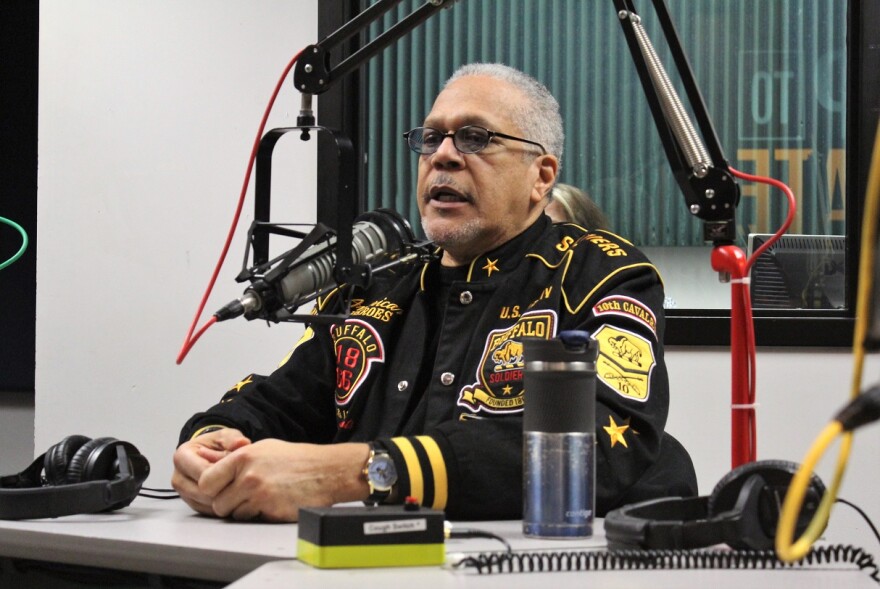Anyone who has even a hazy memory of Bob Marley's song "Buffalo Soldier" knows the broad historical brush strokes of the African-American soldiers.
"Stolen from Africa, brought to America," the song goes. "Fighting on arrival, fighting for survival."
The full history is more complicated.
Sixteen months after the Civil War's conclusion, the United States Congress established the country's first all-black peacetime regiment in the regular U.S. Army. The timing was fortuitous for the unit that would come to be known as the Buffalo Soldiers, first assembled in 1866 at Fort Leavenworth in Kansas.
The country was beginning its rapid westward expansion, which saw Native Americans from the east and central parts of the country forced west. Some took up arms against such displacement. Under pressure to protect white settlers, the Army sent Buffalo Soldiers to battle indigenous hostiles.
The irony that a group of black men — not citizens at the time, and not able to vote — fought against another persecuted group at the behest of white interlopers isn't lost on the Kansas City descendants of the original 10th Cavalry.

"You were having oppressed groups opposing one another," said George Pettigrew, vice president of the Kansas City area's chapter of the National Buffalo Soldiers 9th and 10th (Horse) Cavalry Association. The association was formed in 1966 in Kansas City. Now based in Houston, its members work to spread awareness about the Buffalo Soldiers.
Pettigrew and John Bruce, president of the local chapter, spoke on Thursday with Brian Ellison, guest host of KCUR's Up To Date.
"It was a controversy in the 1860s, in the 1890s, and still today with historians," Pettigrew said.
But controversy, along with a lack of other good options, is no reason to forget the service and sacrifice of the original Buffalo Soldiers, both men said.
"There's something that lies behind every bit of service that every black man ever gave to this country," Pettigrew said. Often, he said, such service was motivated by the idea that "if we prove ourselves ... perhaps, if we go and we do well, we will be accepted by our own nation."
And that service wasn't just about pushing Native Americans onto reservations and making sure they stayed there, said Bruce.

"They were responsible for building forts," he said of the Buffalo Soldiers. "They actually were your first Park Rangers."
They also helped make sure mail made its way safely across the continent.
That's what Pettigrew's great-grandfather Isaac Johnson was doing as a Buffalo Soldier when he was shot in Rice County, Kansas, near Cow Creek.
"He found himself on top of a stage coach, and he was guarding mail," said Pettigrew.
Someone field-dressed Johnson's wound, and he rode on to Fort Union, New Mexico, more than 400 miles away.
"There was no turning back to go to Fort Leavenworth. He had to stay on this assignment," said Pettigrew.
Though his great-grandfather was born into slavery, Pettigrew said Johnson was eager to enlist when Congress first assembled the Buffalo Soldiers.
"This was a coveted job at a time when the economy did not allow African-Americans to have jobs," he noted. "This was a steady job, food, [and a] place to stay."

The Buffalo Soldier regiments distinguished themselves with their service in the Indian Wars. Thirteen enlistees and six officers earned Medals of Honor.
The four regiments that make up the original Buffalo Soldiers went on to take part in every major American engagement, from the Spanish-American to the war in Afghanistan, though the military was desegregated by President Harry Truman in 1948.
Now, Bruce and Pettigrew focus their energy on sharing their knowledge of the Buffalo Soldiers by visiting churches, schools, and libraries in costume. They'll be at the Mid-Continent Library's North Oak Branch on Tuesday, Feb. 13.
"We're more oral historians than we are re-enactors," Pettigrew said.
"Well, John is a re-enactor," Pettigrew said, nodding to his colleague. "But for me, I'm not laying in wet ground on a cold morning."
Listen to Brian Ellison's entire conversation with John Bruce and George Pettigrew here.
Luke X. Martin is the associate producer of KCUR's 'Up To Date.' Contact him at luke@kcur.org or on Twitter.



